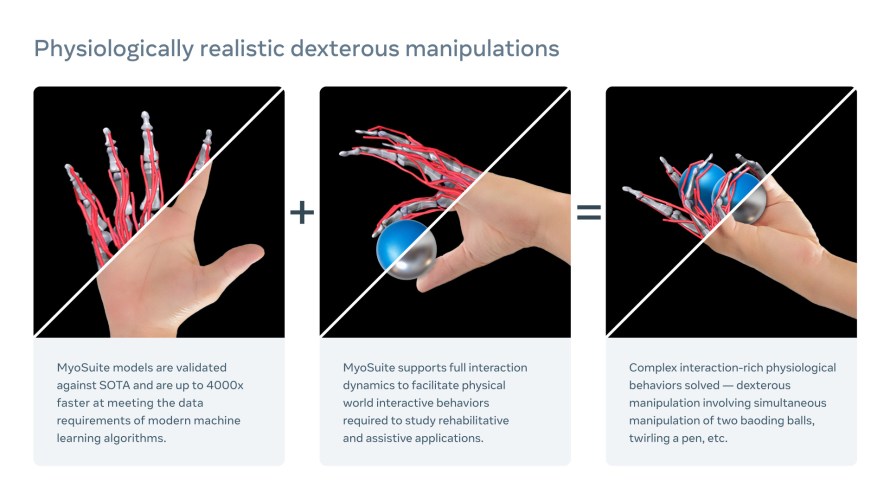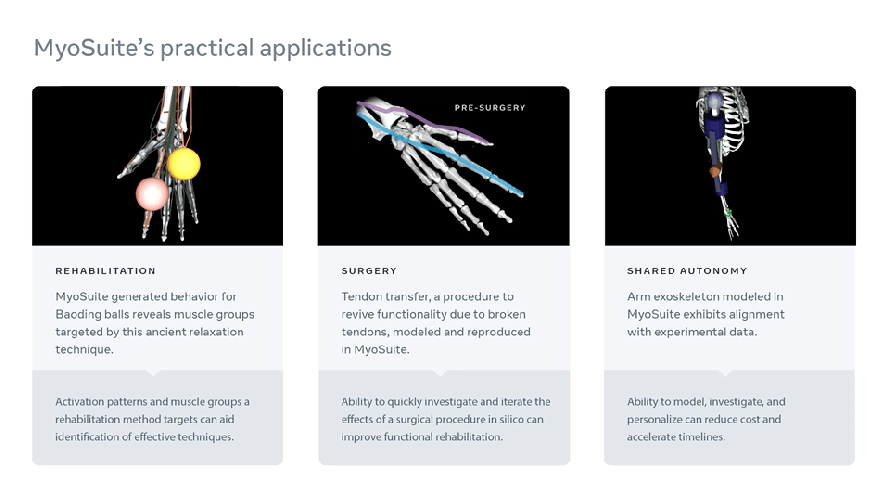
The more intelligent an organism is, the more complex the motor behavior it can exhibit. But what enables such complex decision-making and the motor control to execute those decisions? To explore this question, we’ve developed MyoSuite: a set of musculoskeletal models and tasks that enable the application of ML to solve biomechanic control problems. MyoSuite unifies the two facets of intelligence: motor and neural. We’re releasing MyoSuite and open-sourcing a set of comprehensive benchmarks for the ML community to enable continued research in this area.
MyoSuite’s physiologically realistic musculoskeletal models are orders of magnitude more computationally efficient and scalable than existing models. This allows us to simulate the large number of muscles the human body contains. Finally, we developed and solved a few of the most complex motor control behaviors that haven’t been done before — including dexterous manipulation, like twirling a pen in your hand or turning a key, and have made significant progress on challenging tasks such as the simultaneous manipulation of two Baoding balls in one hand. Now that we can generate physiologically realistic movements in full detail, we anticipate that our results will lead to progress in complex real-world problems like rehabilitation, prosthesis and ergonomics.
MyoSuite, an Ecosystem for Musculoskeletal Motor Control
MyoSuite is designed from the ground up as a comprehensive platform for investigating the physiological details behind musculoskeletal motor control. The MyoSuite ecosystem includes a comprehensive set of physiologically accurate musculoskeletal models that support temporal interaction-rich musculoskeletal dynamics, such as muscle fatigue or sarcopenia, and carefully designed behavioral tasks exposing motor control challenges that are aligned with real-life situations such as daily tasks, injury rehabilitation, and prosthetic/exoskeleton assistance.
Real-World Implications
Not only can MyoSuite synthesize behaviors, but the comprehensive platform can also facilitate applications with real-life implications, such as rehabilitation, surgery, and shared autonomy assistive devices.
Let’s consider a tendon-tear injury. MyoSuite can easily model tendon-transfer, a well-known technique for recovering functionality due to a torn tendon. MyoSuite also has the ability to simulate the outcome, in terms of mobility, achieved by a given surgical procedure and the impact it will have on the functional rehabilitation of the affected parts, following the surgical procedure. The MyoSuite models can also help inform splint support designs and rehabilitation procedures by highlighting activation patterns and muscle groups.
To further this ambitious undertaking, we will need help and contributions from the wider community. In addition to open-sourcing MyoSuite, we will soon be launching MyoChallenge, a NeurIPS competition track where we invite the community to participate in solving two of the most difficult dexterity challenges — die reorientation and simultaneous rotation of two Baoding balls.
Learn more about MyoSuite.
The post An Embodied AI Platform to Solve Biomechanical Problems appeared first on Meta.

















 English (US) ·
English (US) ·